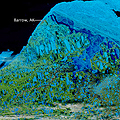This false-color satellite image released by NASA shows the re-emergence of hundreds of ponds scattered across the tundra of Alaska’s North Slope after the winter snows disappeared in early June. The region depicted in the image is roughly 250 kilometers (155 miles) across and is located south of Barrow. The image vividly illustrates just how much of the Arctic tundra is made up of ponds and small lakes, which often form because melting snows are unable to penetrate more than a foot or two into the earth because the permafrost below is frozen year-round. The relative flatness of the terrain also slows drainage and promotes the formation of ponds and lakes. As the climate warms, the permafrost is beginning to thaw in many areas, leading to the draining of some lakes. In other areas, however, the layer of permafrost is actually thickening. Overall, soil temperatures in Arctic tundra are rising, leading to increased release of methane, a powerful greenhouse gas.
Spring Thaw on the North Slope
More From E360
-
Energy
Facing a Hostile Administration, U.S. Offshore Wind Is in Retreat
-
Biodiversity
As Jaguars Recover, Will the Border Wall Block Their U.S. Return?
-
WATER
An E.U. Plan to Slash Micropollutants in Wastewater Is Under Attack
-
INTERVIEW
This Data Scientist Sees Progress in the Climate Change Fight
-
Climate
As Floods Worsen, Pakistan Is the Epicenter of Climate Change
-
Climate
Heat Stress Is a Major Driver of India’s Kidney Disease Epidemic
-
Energy
It’s a ‘Golden Age’ for U.S. LNG Industry, But Climate Risks Loom
-
Climate
How Climate Risks Are Putting Home Insurance Out of Reach
-
INTERVIEW
Inside the Plastics Industry Playbook: Delay, Deny, and Distract
-
Biodiversity
Freeing Captive Bears from Armenia’s Backyards and Basements
-
Food & Agriculture
In Indonesia’s Rainforest, a Mega-Farm Project Is Plowing Ahead
-
FILM CONTEST WINNER
In the Yucatan, the High Cost of a Boom in Factory Hog Farms
